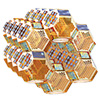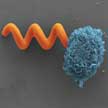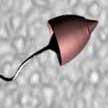Showing Spotlights 1 - 8 of 34 in category All (newest first):
 Researchers have developed biocompatible hydrogel microrobots loaded with magnetic nanoparticles, demonstrating precise control and autonomous motion for potential use in targeted drug delivery and minimally invasive surgery.
Researchers have developed biocompatible hydrogel microrobots loaded with magnetic nanoparticles, demonstrating precise control and autonomous motion for potential use in targeted drug delivery and minimally invasive surgery.
Jun 19th, 2024
 Breakthrough in soft robotics: MXene-cellulose nanofiber actuators mimic plant movements, integrating sensing and actuation in one material.
Breakthrough in soft robotics: MXene-cellulose nanofiber actuators mimic plant movements, integrating sensing and actuation in one material.
Apr 11th, 2024
 Recent advances allow electronic materials to reshape themselves, leading researchers to envision artificial organisms made of self-assembling, self-repairing electronic modules.
Recent advances allow electronic materials to reshape themselves, leading researchers to envision artificial organisms made of self-assembling, self-repairing electronic modules.
Nov 11th, 2023
 Researchers develop fully recyclable, self-healing soft robots made of a novel dynamic polymer, enabling rapid wireless reprogramming and reshaping into new functions. The material overcomes previous challenges in recyclability for sustainable soft robotics.
Researchers develop fully recyclable, self-healing soft robots made of a novel dynamic polymer, enabling rapid wireless reprogramming and reshaping into new functions. The material overcomes previous challenges in recyclability for sustainable soft robotics.
Aug 4th, 2023
 Combining the benefits of both fluid and solids, researchers have demonstrated various functions for their slimebots, including navigation in narrow channels much smaller than their size; object capture operations via the curl or endocytosis modes; and circuit repair and controlled switching using their own conductive properties that can even be reconfigured as self-healing strain sensors for monitoring human motion. The widely applicable working environment of these novel magnetic slime robots make them promising for future applications in biomedical and wearable devices.
Combining the benefits of both fluid and solids, researchers have demonstrated various functions for their slimebots, including navigation in narrow channels much smaller than their size; object capture operations via the curl or endocytosis modes; and circuit repair and controlled switching using their own conductive properties that can even be reconfigured as self-healing strain sensors for monitoring human motion. The widely applicable working environment of these novel magnetic slime robots make them promising for future applications in biomedical and wearable devices.
Apr 4th, 2022
 The immune system's activation of macrophages, a type of immune cells that are on the lookout for pathogens, is a major obstacle for developing functional medical microrobots that can operate in vivo for a prolonged period of time. Researchers are trying to overcome this challenge by 'camouflaging' therapeutic nanoparticles with special coatings so that they avoid detection by macrophages. In new work, researchers report the development of stealth microrobots that can fly under the radar of the immune system, and hence prolong their window of operation since they do not get eliminated.
The immune system's activation of macrophages, a type of immune cells that are on the lookout for pathogens, is a major obstacle for developing functional medical microrobots that can operate in vivo for a prolonged period of time. Researchers are trying to overcome this challenge by 'camouflaging' therapeutic nanoparticles with special coatings so that they avoid detection by macrophages. In new work, researchers report the development of stealth microrobots that can fly under the radar of the immune system, and hence prolong their window of operation since they do not get eliminated.
Oct 26th, 2020
 Researchers have developed a hybrid sperm micromotor, which can carry a payload and efficiently and controllably swim against flowing blood. Sperm-based micromotors hold several advantages, in particular their powerful propulsion generated by the beating of the sperm flagella. Sperm are also able to swim for several days with a drag force up to 100 pN. The most important feature of sperm micromotors to operate in the bloodstream is their ability to swim against flow as well as close to boundaries, where the blood velocity is lower than the average velocity, due to shear stress.
Researchers have developed a hybrid sperm micromotor, which can carry a payload and efficiently and controllably swim against flowing blood. Sperm-based micromotors hold several advantages, in particular their powerful propulsion generated by the beating of the sperm flagella. Sperm are also able to swim for several days with a drag force up to 100 pN. The most important feature of sperm micromotors to operate in the bloodstream is their ability to swim against flow as well as close to boundaries, where the blood velocity is lower than the average velocity, due to shear stress.
Oct 8th, 2020
 Biology serves as an important proof-of-principle, and design challenge, for artificial intelligence and shape changing robots. Numerous organisms successfully exploit shape change as a mechanism for adaptation and survival. However, for robotics designers one fundamental question to start with is that it is unclear when and how robots should change their shape. A recent progress review provides an overview of the literature related to robots that change shape to enhance and expand their functionality.
Biology serves as an important proof-of-principle, and design challenge, for artificial intelligence and shape changing robots. Numerous organisms successfully exploit shape change as a mechanism for adaptation and survival. However, for robotics designers one fundamental question to start with is that it is unclear when and how robots should change their shape. A recent progress review provides an overview of the literature related to robots that change shape to enhance and expand their functionality.
Oct 6th, 2020
 Researchers have developed biocompatible hydrogel microrobots loaded with magnetic nanoparticles, demonstrating precise control and autonomous motion for potential use in targeted drug delivery and minimally invasive surgery.
Researchers have developed biocompatible hydrogel microrobots loaded with magnetic nanoparticles, demonstrating precise control and autonomous motion for potential use in targeted drug delivery and minimally invasive surgery.
 Subscribe to our Nanotechnology Spotlight feed
Subscribe to our Nanotechnology Spotlight feed





